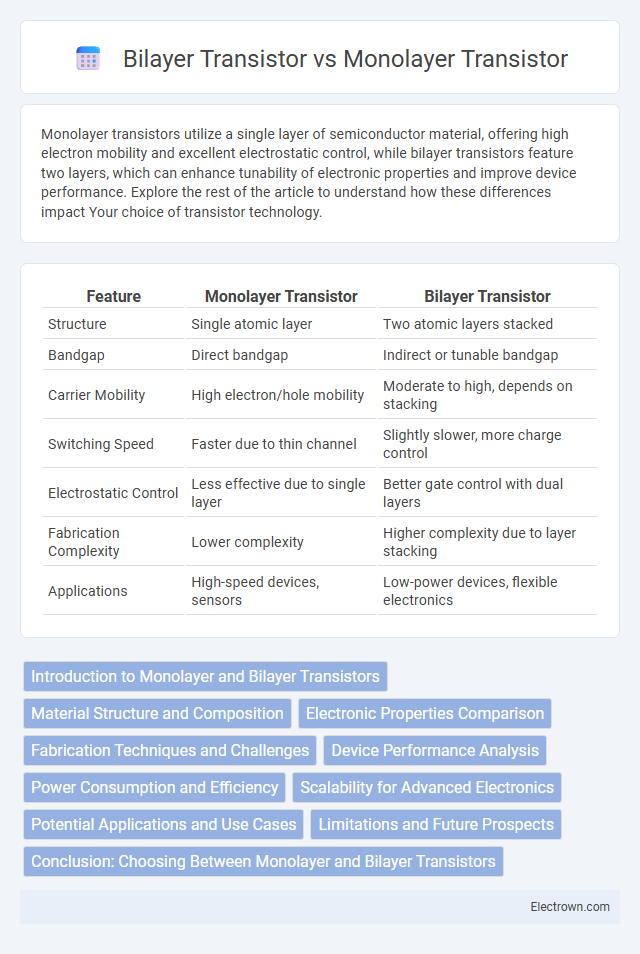Monolayer transistors utilize a single layer of semiconductor material, offering high electron mobility and excellent electrostatic control, while bilayer transistors feature two layers, which can enhance tunability of electronic properties and improve device performance. Explore the rest of the article to understand how these differences impact Your choice of transistor technology.
Table of Comparison
| Feature | Monolayer Transistor | Bilayer Transistor |
|---|---|---|
| Structure | Single atomic layer | Two atomic layers stacked |
| Bandgap | Direct bandgap | Indirect or tunable bandgap |
| Carrier Mobility | High electron/hole mobility | Moderate to high, depends on stacking |
| Switching Speed | Faster due to thin channel | Slightly slower, more charge control |
| Electrostatic Control | Less effective due to single layer | Better gate control with dual layers |
| Fabrication Complexity | Lower complexity | Higher complexity due to layer stacking |
| Applications | High-speed devices, sensors | Low-power devices, flexible electronics |
Introduction to Monolayer and Bilayer Transistors
Monolayer transistors consist of a single atomic layer of semiconductor material, offering exceptional electrostatic control and high carrier mobility essential for next-generation nanoelectronics. Bilayer transistors involve two stacked atomic layers, providing tunable bandgaps and enhanced on/off current ratios through interlayer coupling, which improves device performance in flexible and transparent electronics. Your choice between monolayer and bilayer transistor architectures influences device scalability, electrical characteristics, and application-specific functionalities in advanced semiconductor technologies.
Material Structure and Composition
Monolayer transistors consist of a single atomic layer of materials such as graphene or transition metal dichalcogenides (TMDs), providing exceptional electrical and mechanical properties due to their reduced thickness and unique band structure. Bilayer transistors, made from two stacked atomic layers, allow for tunable electronic properties like bandgap modulation through interlayer interactions, enhancing device versatility. Your choice between monolayer and bilayer transistors impacts performance, as bilayers offer greater control over electronic characteristics, while monolayers provide superior flexibility and transparency.
Electronic Properties Comparison
Monolayer transistors exhibit higher electron mobility due to reduced interlayer scattering, resulting in faster switching speeds compared to bilayer transistors. Bilayer transistors possess a tunable bandgap enabled by interlayer coupling, which allows better control over electronic properties such as conductivity and on/off current ratios. The enhanced electrostatic control in bilayer devices improves subthreshold slope performance, making them suitable for low-power applications while monolayer devices prioritize high-speed operations.
Fabrication Techniques and Challenges
Monolayer transistors are typically fabricated using chemical vapor deposition (CVD) or mechanical exfoliation, which facilitate atomically thin, uniform layers but pose challenges in achieving large-scale consistency and defect control. Bilayer transistors, often manufactured through layer-by-layer stacking or CVD growth techniques, face increased complexity in precise layer alignment and interlayer coupling, impacting device performance and reproducibility. Understanding these fabrication nuances is crucial for optimizing Your device's electrical properties and scalability in nanoelectronics.
Device Performance Analysis
Monolayer transistors exhibit superior electron mobility and faster switching speeds due to their atomically thin, uniform channel, leading to enhanced device performance in high-frequency applications. Bilayer transistors offer improved electrostatic control and tunable bandgap properties, which reduce short-channel effects and enhance current modulation compared to monolayers. Your choice between monolayer and bilayer transistors should consider the trade-off between speed and control to optimize device efficiency and power consumption.
Power Consumption and Efficiency
Monolayer transistors exhibit lower power consumption due to their atomically thin structure, which minimizes leakage currents and enhances electrostatic control. Bilayer transistors, while slightly thicker, offer improved charge carrier mobility, leading to higher operational efficiency under certain conditions. Optimizing the balance between power consumption and efficiency depends on the specific application requirements, with monolayers favored for ultra-low power devices and bilayers suited for higher performance tasks.
Scalability for Advanced Electronics
Monolayer transistors, composed of a single atomic layer, offer superior electrostatic control and reduced short-channel effects, making them highly scalable for advanced electronics. Bilayer transistors provide enhanced tunability of electronic properties through interlayer coupling but face challenges in maintaining uniform performance at nanometer scales. Your choice between monolayer and bilayer transistors will impact device miniaturization, power efficiency, and integration density in next-generation integrated circuits.
Potential Applications and Use Cases
Monolayer transistors, characterized by a single atomic layer, exhibit exceptional electron mobility ideal for ultra-fast, low-power flexible electronics and high-frequency applications in wearable devices and sensors. Bilayer transistors offer tunable bandgaps through electric field modulation, making them suitable for optoelectronic devices, including photodetectors and modulators in integrated photonic circuits. Both types enable advancements in next-generation nanoelectronics, with monolayer variants excelling in speed and bilayer structures providing enhanced control for multifunctional device applications.
Limitations and Future Prospects
Monolayer transistors face limitations in current saturation and carrier mobility due to their atomic thickness, impacting device performance and thermal stability. Bilayer transistors offer improved electrical characteristics such as bandgap tunability and enhanced on/off ratios, yet challenges remain in uniform bilayer synthesis and interlayer coupling control. Future prospects involve optimizing material quality and integrating novel 2D heterostructures to achieve higher-speed, low-power electronic devices with scalability for next-generation nanoelectronics.
Conclusion: Choosing Between Monolayer and Bilayer Transistors
Monolayer transistors offer superior electron mobility and reduced short-channel effects, making them ideal for high-speed, low-power applications. Bilayer transistors provide enhanced electrostatic control and tunable bandgap properties, beneficial for flexible electronics and optoelectronic devices. Selecting between monolayer and bilayer transistors depends on targeted device performance metrics, with monolayers favored for speed and bilayers preferred for versatile functionality.
Monolayer transistor vs Bilayer transistor Infographic

 electrown.com
electrown.com